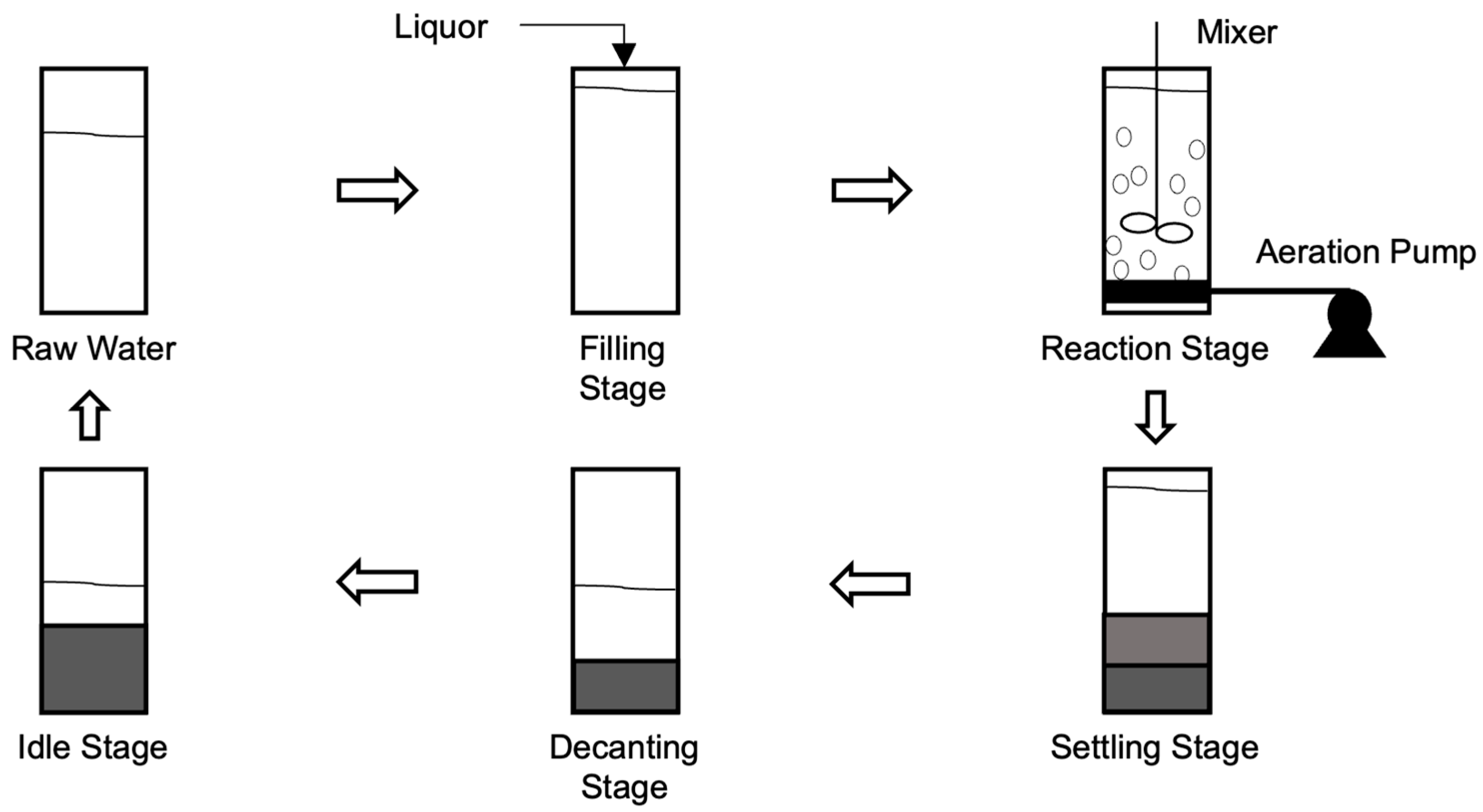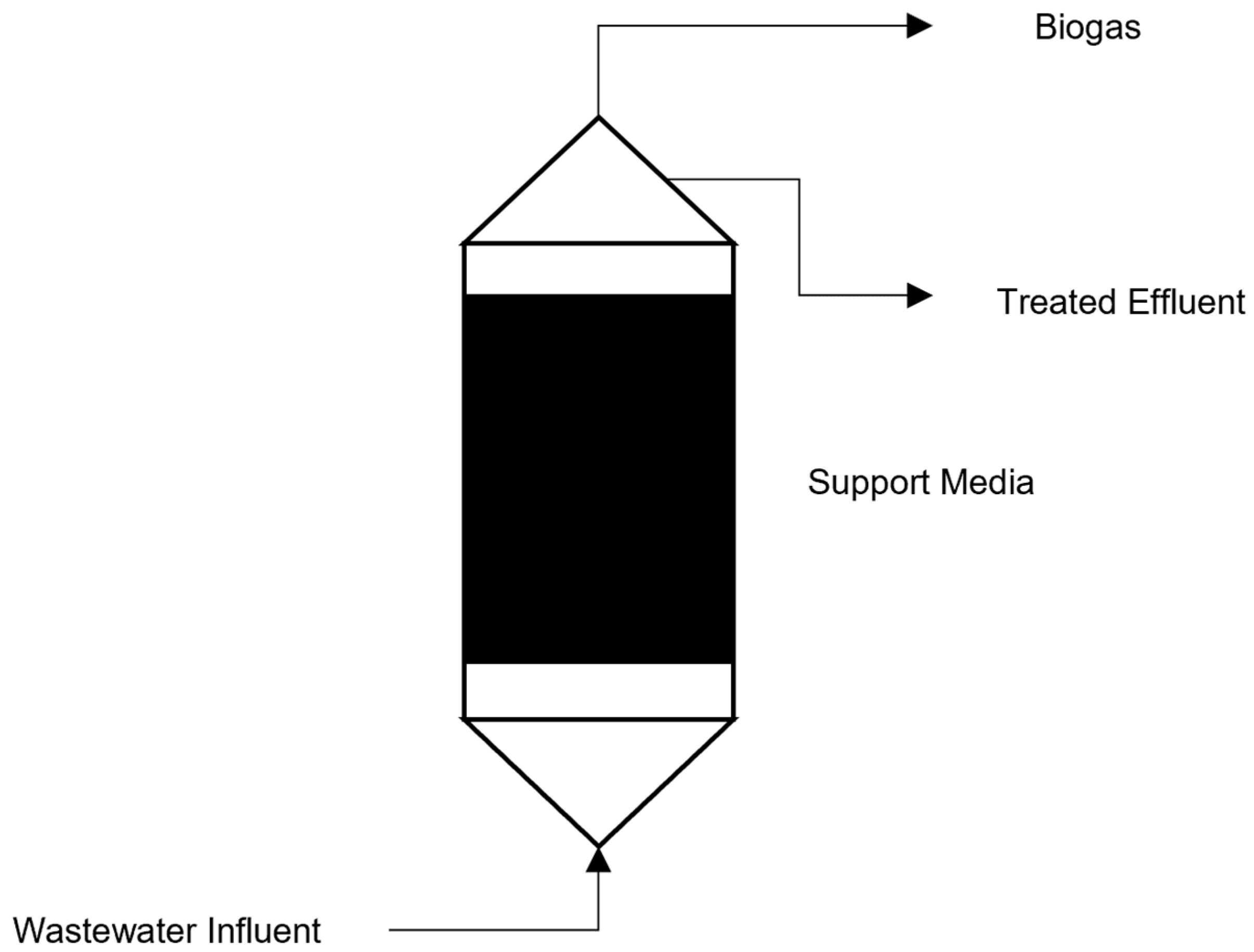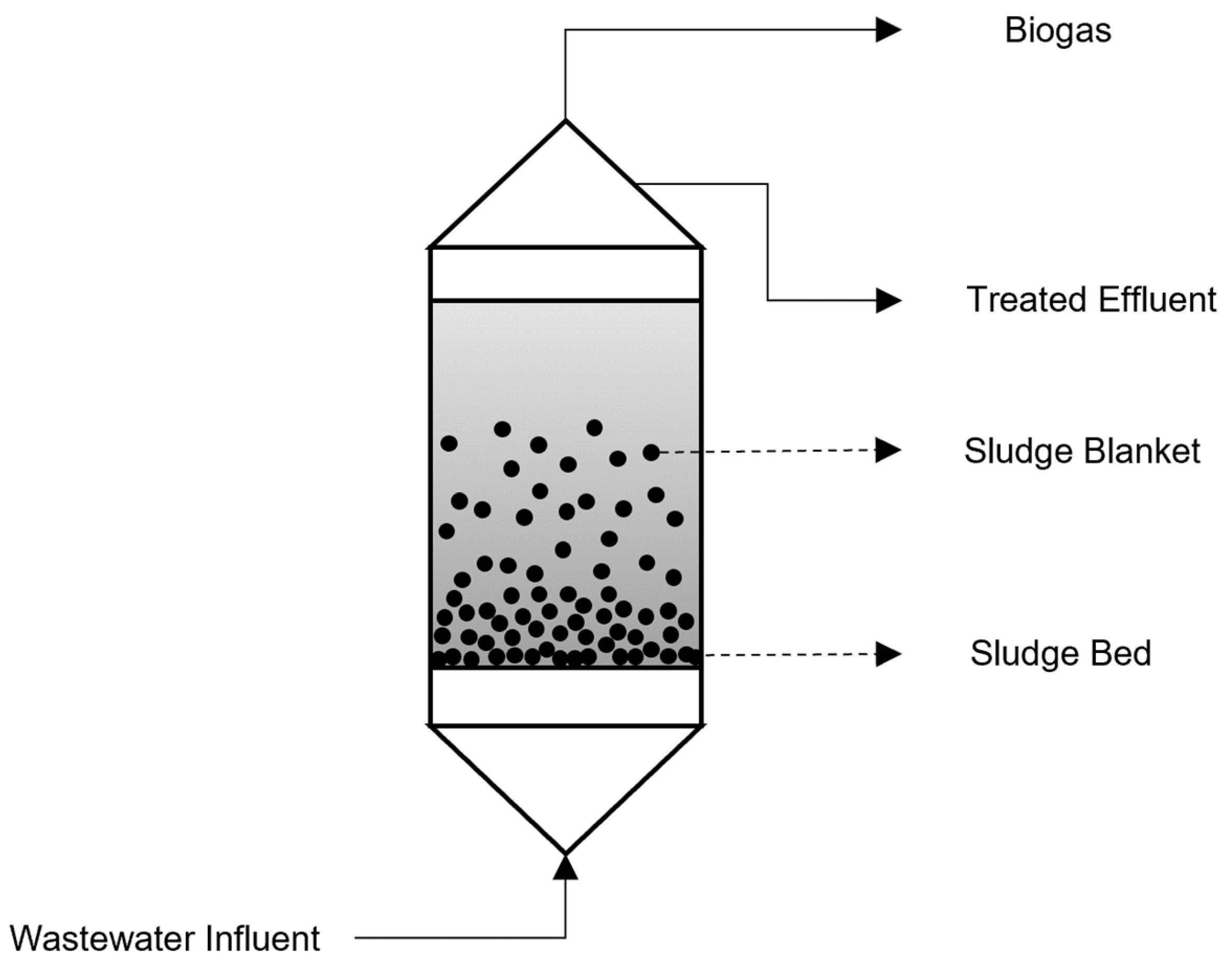A Review of Biological Processes for Dairy Wastewater Treatment and the Effect of Physical Parameters Which Affect Their Efficiency
Abstract
1. Introduction
2. Treatment Options
| Process | Process Type | %Removal | Merits and Demerits | Reference |
|---|---|---|---|---|
| Activated sludge | Aerobic | BOD5: 95% |
| [22] |
| SBR | Aerobic & Anaerobic | COD: 95–98% TS: 60% TN: 40% NH3: >90% TP: >90% |
| [8,23] |
| MBR | Aerobic & Membrane filtration | COD: 95% BOD5: 95–99% TN: 96% NH4: 99.9% TP: 80% |
| [24,25] |
| PBR | Anaerobic | COD: 96% BOD5: 93% VSS: 90% |
| [7] |
| AFs | Anaerobic | COD: 90% FOG: 47% |
| [26,27] |
| UASBR | Anaerobic | COD: 96.3% |
| [28] |
| AF + SBR | Aerobic & Anaerobic | COD: 90% | [27] | |
| UASBR + Aerobic Denitrification | Aerobic & Anaerobic | COD: 95% | [20] |
2.1. Aerobic Treatment Processes
2.2. Activated Sludge
2.3. Sequencing Batch Reactors
2.4. Membrane Bioreactor
2.5. Anaerobic Processes
2.6. Anaerobic Filters
2.7. Anaerobic Packed Bed Reactors
2.8. Up-Flow Anaerobic Sludge Blanket Reactors
2.9. Aerobic–Anaerobic Systems
3. The Effects of Experimental Parameters on the Performance of Biological Treatment Systems
3.1. pH Adjustment
3.2. Dissolved O2 Levels
3.3. Hydraulic Retention Time
3.4. Aeration and Agitation
3.5. Temperature
4. Accessory Treatment Options
4.1. Hydrolysis
4.2. Coagulation
4.3. Membrane Filtration
| Process | Examples | Merits & Demerits | Reference |
|---|---|---|---|
| Hydrolysis |
|
| [35,39,46,53,54] |
| Coagulation |
|
| [46,47,48,55] |
| Membrane Filtration |
|
| [49,50,51] |
5. The Way Forward and Conclusions
- The effects that various parameters have on the efficiency of aerobic and anaerobic digestion must be examined. It is important to examine and understand the effects that changes in multiple parameters will have collectively, and possible synergistic effects between these parameters, as this will aid in developing better control strategies for optimal DWW treatment.
- The optimal operating conditions for each of these parameters based on the discharge standards to be met and the varying characteristics of different DWWs must be determined.
- Future work must consider developing a more complete understanding of the reactions taking place in both aerobic and anaerobic digestion to be able to better optimize each process individually and together. This would be a big step in understanding the synergies between the two processes when used in a multi-stage system for the improved efficacy of DWW treatment processes.
- Considerations must be made into optimizing pre-treatments that can be used in conjunction with a biological treatment system, and to evaluate the effects that this will have on the remediation efficiency of the process. This will be primarily aimed at treating the wastewater and not at the production of biogas or methane.
- The viability of accessory treatment options must be made a key consideration and evaluated for the purposes of overcoming the various shortfalls of certain biological processes.
Author Contributions
Funding
Conflicts of Interest
References
- United States Department of Agriculture. Dairy: World Markets and Trade; United States Department of Agriculture: Washington, DC, USA, 2022.
- Dogan, O.B.; Meneses, Y.E.; Flores, R.A.; Wang, B. Risk-based assessment and criteria specification of the microbial safety of wastewater reuse in food processing: Managing Listeria monocytogenes contamination in pasteurized fluid milk. Water Res. 2020, 171, 115466. [Google Scholar] [CrossRef]
- 2016-06-SA’s Farmers Can Benefit by Reducing Their Water Use–Wits University. Available online: https://www.wits.ac.za/news/latest-news/in-their-own-words/2016/2016-06/sas-farmers-can-benefit-by-reducing-their-water-use.html (accessed on 2 May 2023).
- Water Access in South Africa|Water for All. Available online: http://www.12.000.scripts.mit.edu/mission2017/case-studies/water-access-in-south-africa/ (accessed on 2 May 2023).
- Van Heerdan, B. Suid-Afrikaanse Melkprosesseer South African Milk Processors’ Organisation dersorganisasie A Milk SA publication compiled by the Milk Producers’ Organisation. 2022. Available online: https://www.google.com/url?sa=t&rct=j&q=&esrc=s&source=web&cd=&ved=2ahUKEwiu5OLrtNWBAxXTWEEAHaPiAYYQFnoECBQQAQ&url=https%3A%2F%2Fmilksa.co.za%2Fsites%2Fdefault%2Ffiles%2F2018-09%2FLAC004%2520Nov%25202017.pdf&usg=AOvVaw07hNM16NuvQXnHrUDjHDjB&opi=89978449 (accessed on 10 July 2023).
- Molewa, B.E. Revision of General Authorisations in Terms of Section 39 of the National Water Act, 1998 (Act No. 36 of 1998) (the Act). In Government Gazette No. 36820; Government Gazette of South Africa: Pretoria, South Africa, 2013. [Google Scholar]
- Joshiba, G.J.; Kumar, P.S.; Femina, C.C.; Jayashree, E.; Racchana, R.; Sivanesan, S. Critical review on biological treatment strategies of dairy wastewater. Desalination Water Treat. 2019, 160, 94–109. [Google Scholar] [CrossRef]
- Slavov, A.K. General characteristics and treatment possibilities of dairy wastewater—A review. Food Technol. Biotechnol. 2017, 55, 14–28. [Google Scholar] [CrossRef] [PubMed]
- Najafpour, G.; Najafpour, G.D.; Hashemiyeh, B.A.; Asadi, M.; Ghasemi, M.B. Biological treatment of dairy wastewater in an upflow anaerobic sludge-fixed film bioreactor. J. Agric. Food Chem. 2008, 4, 251–257. [Google Scholar]
- Demirel, B.; Yenigun, O.; Onay, T.T. Anaerobic treatment of dairy wastewaters: A review. Process. Biochem. 2005, 40, 2583–2595. [Google Scholar] [CrossRef]
- Farizoglu, B.; Keskinler, B.; Yildiz, E.; Nuhoglu, A. Simultaneous removal of C, N, P from cheese whey by jet loop membrane bioreactor (JLMBR). J. Hazard. Mater. 2007, 146, 399–407. [Google Scholar] [CrossRef] [PubMed]
- Janczukowicz, W.; Zieliński, M.; Dębowski, M. Biodegradability evaluation of dairy effluents originated in selected sections of dairy production. Bioresour. Technol. 2008, 99, 4199–4205. [Google Scholar] [CrossRef] [PubMed]
- Watkins, M.; Nash, D. Dairy Factory Wastewaters, Their Use on Land and Possible Environmental Impacts—A Mini Review. Open Agric. J. 2010, 4, 1–9. [Google Scholar] [CrossRef]
- Wang, S.; Rao, N.C.; Qiu, R.; Moletta, R. Performance and kinetic evaluation of anaerobic moving bed biofilm reactor for treating milk permeate from dairy industry. Bioresour. Technol. 2009, 100, 5641–5647. [Google Scholar] [CrossRef]
- Gannoun, H.; Khelifi, E.; Bouallagui, H.; Touhami, Y.; Hamdi, M. Ecological clarification of cheese whey prior to anaerobic digestion in upflow anaerobic filter. Bioresour. Technol. 2008, 99, 6105–6111. [Google Scholar] [CrossRef]
- Yang, P.; Zhang, R.; McGarvey, J.A.; Benemann, J.R. Biohydrogen production from cheese processing wastewater by anaerobic fermentation using mixed microbial communities. Int. J. Hydrogen Energy 2007, 32, 4761–4771. [Google Scholar] [CrossRef]
- Carvalho, F.; Prazeres, A.R.; Rivas, J. Cheese whey wastewater: Characterization and treatment. Sci. Total Environ. 2013, 445–446, 385–396. [Google Scholar] [CrossRef]
- Venetsaneas, N.; Antonopoulou, G.; Stamatelatou, K.; Kornaros, M.; Lyberatos, G. Using cheese whey for hydrogen and methane generation in a two-stage continuous process with alternative pH controlling approaches. Bioresour. Technol. 2009, 100, 3713–3717. [Google Scholar] [CrossRef]
- Geilman, W.G.; Schmidt, D.; Herfurth-Kennedy, C.; Path, J.; Cullor, J. Production of an Electrolyte Beverage from Milk Permeate. J. Dairy Sci. 1992, 75, 2364–2369. [Google Scholar] [CrossRef]
- B Britz, T.J.; van Schalkwyk, C.; Hung, Y.-T. Treatment of Dairy Processing Wastewaters. In Handbook of Industrial and Hazardous Wastes Treatment; CRC Press: Boca Raton, FL, USA, 2004; pp. 673–705. [Google Scholar] [CrossRef]
- Zhao, K.; Wu, Y.W.; Young, S.; Chen, X.J. Biological Treatment of Dairy Wastewater: A Mini Review. J. Environ. Inform. Lett. 2020, 4, 22–31. [Google Scholar] [CrossRef]
- Lateef, S.A.; Beneragama, N.; Yamashiro, T.; Iwasaki, M.; Umetsu, K. Batch anaerobic co-digestion of cow manure and waste milk in two-stage process for hydrogen and methane productions. Bioprocess Biosyst. Eng. 2014, 37, 355–363. [Google Scholar] [CrossRef]
- Malaspina, F.; Stante, L.; Cellamare, C.; Tilche, A. Cheese whey and cheese factory wastewater treatment with a biological anaerobic-aerobic process. Water Sci. Technol. 1995, 32, 59–72. [Google Scholar] [CrossRef]
- Stepanov, S.; Solkina, O.; Stepanov, A. Dairy Wastewater Treatment Using Membrane Bioreactor. IOP Conf. Series: Earth Environ. Sci. 2019, 272, 022249. [Google Scholar] [CrossRef]
- Scott, J.; Smith, K. A bioreactor coupled to a membrane to provide aeration and filtration in ice-cream factory wastewater remediation. Water Res. 1997, 31, 69–74. [Google Scholar] [CrossRef]
- Rajagopal, R.; Torrijos, M.; Kumar, P.; Mehrotra, I. Substrate removal kinetics in high-rate upflow anaerobic filters packed with low-density polyethylene media treating high-strength agro-food wastewaters. J. Environ. Manag. 2013, 116, 101–106. [Google Scholar] [CrossRef] [PubMed]
- Omil, F.; Garrido, J.M.; Arrojo, B.; Méndez, R. Anaerobic filter reactor performance for the treatment of complex dairy wastewater at industrial scale. Water Res. 2003, 37, 4099–4108. [Google Scholar] [CrossRef]
- Buntner, D.; Sánchez, A.; Garrido, J. Feasibility of combined UASB and MBR system in dairy wastewater treatment at ambient temperatures. Chem. Eng. J. 2013, 230, 475–481. [Google Scholar] [CrossRef]
- Bae, T.-H.; Han, S.-S.; Tak, T.-M. Membrane sequencing batch reactor system for the treatment of dairy industry wastewater. Process. Biochem. 2003, 39, 221–231. [Google Scholar] [CrossRef]
- Vashi, H.; Iorhemen, O.T.; Tay, J.H. Aerobic granulation: A recent development on the biological treatment of pulp and paper wastewater. Environ. Technol. Innov. 2018, 9, 265–274. [Google Scholar] [CrossRef]
- Goli, A.; Shamiri, A.; Khosroyar, S.; Talaiekhozani, A.; Sanaye, R.; Azizi, K. A review on different aerobic and anaerobic treatment methods in dairy industry wastewater. J. Environ. Treat. Tech. 2019, 7, 113–141. [Google Scholar]
- Meyo, H.B.; Njoya, M.; Basitere, M.; Ntwampe, S.K.O.; Kaskote, E. Treatment of poultry slaughterhouse wastewater (Psw) using a pretreatment stage, an expanded granular sludge bed reactor (egsb), and a membrane bioreactor (mbr). Membranes 2021, 11, 345. [Google Scholar] [CrossRef]
- Bal, A.S.; Dhagat, N.N. Upflow anaerobic sludge blanket reactor—A review. Indian J. Environ. Health 2001, 43, 1–82. [Google Scholar] [PubMed]
- Hanrahan, G. Aqueous Chemistry. In Key Concepts in Environmental Chemistry; Academic Press: Cambridge, MA, USA, 2012; pp. 73–106. [Google Scholar] [CrossRef]
- Pascale, N.C.; Chastinet, J.J.; Bila, D.M.; Sant̀anna, G.L.; Quitério, S.L.; Vendramel, S.M.R. Enzymatic hydrolysis of floatable fatty wastes from dairy and meat food-processing industries and further anaerobic digestion. Water Sci. Technol. 2019, 79, 985–992. [Google Scholar] [CrossRef]
- Karadag, D.; Köroğlu, O.E.; Ozkaya, B.; Cakmakci, M. A review on anaerobic biofilm reactors for the treatment of dairy industry wastewater. Process. Biochem. 2015, 50, 262–271. [Google Scholar] [CrossRef]
- Passeggi, M.; López, I.; Borzacconi, L. Modified UASB reactor for dairy industry wastewater: Performance indicators and comparison with the traditional approach. J. Clean. Prod. 2012, 26, 90–94. [Google Scholar] [CrossRef]
- Demirer, G.; Chen, S. Effect of retention time and organic loading rate on anaerobic acidification and biogasification of dairy manure. J. Chem. Technol. Biotechnol. 2004, 79, 1381–1387. [Google Scholar] [CrossRef]
- Bella, K.; Rao, P.V. Anaerobic digestion of dairy wastewater: Effect of different parameters and co-digestion options—A review. Biomass-Convers. Biorefinery 2021, 13, 2527–2552. [Google Scholar] [CrossRef]
- Tocchi, C.; Federici, E.; Fidati, L.; Manzi, R.; Vincigurerra, V.; Petruccioli, M. Aerobic treatment of dairy wastewater in an industrial three-reactor plant: Effect of aeration regime on performances and on protozoan and bacterial communities. Water Res. 2012, 46, 3334–3344. [Google Scholar] [CrossRef] [PubMed]
- Dubber, D.; Gray, N. The effect of anoxia and anaerobia on ciliate community in biological nutrient removal systems using laboratory-scale sequencing batch reactors (SBRs). Water Res. 2011, 45, 2213–2226. [Google Scholar] [CrossRef]
- Feng, Y.; He, Z.; Ong, S.L.; Hu, J.; Zhang, Z.; Ng, W.J. Optimization of agitation, aeration, and temperature conditions for maximum β-mannanase production. Enzym. Microb. Technol. 2003, 32, 282–289. [Google Scholar] [CrossRef]
- Shioya, S.; Morikawa, M.; Kajihara, Y.; Shimizu, H. Optimization of agitation and aeration conditions for maximum virginiamycin production. Appl. Microbiol. Biotechnol. 1999, 51, 164–169. [Google Scholar] [CrossRef] [PubMed]
- Goff, H.D.; Hill, A.; Ferrer, M.A. Milk Lipids-Chemical Properties; Physical Properties; Structure and Fat Globules; Func-tional Properties. In Dairy Science and Technology eBook; CRC Press: Boca Raton, FL, USA, 2005. [Google Scholar]
- Leal, M.C.; Freire, D.M.; Cammarota, M.C.; Sant’anna, G.L. Effect of enzymatic hydrolysis on anaerobic treatment of dairy wastewater. Process. Biochem. 2006, 41, 1173–1178. [Google Scholar] [CrossRef]
- Mobarak-Qamsari, E.; Kasra-Kermanshahi, R.; Nosrati, M.; Amani, T. Enzymatic Pre-Hydrolysis of high fat Content Dairy Wastewater as a Pretreatment for Anaerobic Digestion. Int. J. Environ. Res. 2012, 6, 475–480. Available online: https://www.SID.ir (accessed on 9 October 2023).
- Mateus, G.A.P.; Formentini-Schmitt, D.M.; Nishi, L.; Fagundes-Klen, M.R.; Gomes, R.G.; Bergamasco, R. Coagulation/Flocculation with Moringa oleifera and Membrane Filtration for Dairy Wastewater Treatment. Water Air Soil Pollut. 2017, 228, 342. [Google Scholar] [CrossRef]
- Loloei, M.; Nekonam, G.; Alidadi, H.; Kor, Y. Study of the coagulation process in wastewater treatment of dairy industries. Int. J. Environ. Health Sci. Eng. 2014, 3, 12. [Google Scholar] [CrossRef]
- Muniz, G.L.; Da Silva, T.C.F.; Borges, A.C. Assessment and optimization of the use of a novel natural coagulant (Guazuma ulmifolia) for dairy wastewater treatment. Sci. Total. Environ. 2020, 744, 140864. [Google Scholar] [CrossRef] [PubMed]
- Bortoluzzi, A.C.; Faitão, J.A.; Di Luccio, M.; Dallago, R.M.; Steffens, J.; Zabot, G.L.; Tres, M.V. Dairy wastewater treatment using integrated membrane systems. J. Environ. Chem. Eng. 2017, 5, 4819–4827. [Google Scholar] [CrossRef]
- Andrade, L.; Mendes, F.; Espindola, J.; Amaral, M. Nanofiltration as tertiary treatment for the reuse of dairy wastewater treated by membrane bioreactor. Sep. Purif. Technol. 2014, 126, 21–29. [Google Scholar] [CrossRef]
- Zhao, S.; Liao, Z.; Fane, A.; Li, J.; Tang, C.; Zheng, C.; Lin, J.; Kong, L. Engineering antifouling reverse osmosis membranes: A review. Desalination 2021, 499, 114857. [Google Scholar] [CrossRef]
- Li, X.; Zhang, R. Aerobic treatment of dairy wastewater with sequencing batch reactor systems. Bioprocess Biosyst. Eng. 2002, 25, 103–109. [Google Scholar] [CrossRef] [PubMed]
- Khorasani, R.; Khodaparasti, M.S.; Tavakoli, O. Hydrogen production from dairy wastewater using catalytic supercritical water gasification: Mechanism and reaction pathway. Int. J. Hydrogen Energy 2021, 46, 22368–22384. [Google Scholar] [CrossRef]
- Justina, M.D.; Muniz, B.R.B.; Bröring, M.M.; Costa, V.J.; Skoronski, E. Using vegetable tannin and polyaluminium chloride as coagulants for dairy wastewater treatment: A comparative study. J. Water Process. Eng. 2018, 25, 173–181. [Google Scholar] [CrossRef]





| Processing Effluent | pH | (mg/L) | Reference | ||||||
|---|---|---|---|---|---|---|---|---|---|
| BOD5 | COD | FOG | TS | TSS | TN | TP | |||
| Mixed Dairy | 3.38–12.08 | 240–5900 | 500–10,400 | 20–1920 | 710–7000 | 60–5800 | 10–660 | 0–600 | [9,10,11,12,13,14,15,16,17,18,19,20] |
| Milk | 5–9.50 | 500–1300 | 950–2400 | - | - | - | - | - | [10] |
| Cheese | 3.38–9.50 | 590–5000 | 1000–63,300 | 330–2600 | 1920–53,200 | 190–2500 | 18–830 | 5–280 | [10,12,13,20] |
| Cheese Whey | 3.92–9.50 | 27,000–60,000 | 50,000–102,100 | 900–14,000 | 55,000–70,900 | 1270–22,150 | 200–1760 | 120–530 | [9,10,15,17,18] |
| Whey | 9–5 | 590–1210 | 1070–2180 | - | - | 80–440 | - | - | [19] |
| Milk Permeate | 5.55–6.52 | - | 52,940–57,460 | - | 11,610–15,390 | 300–450 | 350–450 | 2500 | [11,14] |
| Ice Cream | 5.10–6.96 | 2450 | 5200 | - | 3900 | 3100 | - | 14 | [16] |
| Butter | 12.08 | 220–2650 | 8930 | 2880 | - | 700–5070 | - | - | [12] |
| Washing Wastewater | 10.37 | 3470 | 14,640 | 3110 | - | 3820 | - | - | [12] |
Disclaimer/Publisher’s Note: The statements, opinions and data contained in all publications are solely those of the individual author(s) and contributor(s) and not of MDPI and/or the editor(s). MDPI and/or the editor(s) disclaim responsibility for any injury to people or property resulting from any ideas, methods, instructions or products referred to in the content. |
© 2024 by the authors. Licensee MDPI, Basel, Switzerland. This article is an open access article distributed under the terms and conditions of the Creative Commons Attribution (CC BY) license (https://creativecommons.org/licenses/by/4.0/).
Share and Cite
Ramsuroop, J.; Gutu, L.; Ayinde, W.B.; Basitere, M.; Manono, M.S. A Review of Biological Processes for Dairy Wastewater Treatment and the Effect of Physical Parameters Which Affect Their Efficiency. Water 2024, 16, 537. https://doi.org/10.3390/w16040537
Ramsuroop J, Gutu L, Ayinde WB, Basitere M, Manono MS. A Review of Biological Processes for Dairy Wastewater Treatment and the Effect of Physical Parameters Which Affect Their Efficiency. Water. 2024; 16(4):537. https://doi.org/10.3390/w16040537
Chicago/Turabian StyleRamsuroop, Jyestha, Laurah Gutu, Wasiu B. Ayinde, Moses Basitere, and Malibongwe S. Manono. 2024. "A Review of Biological Processes for Dairy Wastewater Treatment and the Effect of Physical Parameters Which Affect Their Efficiency" Water 16, no. 4: 537. https://doi.org/10.3390/w16040537
APA StyleRamsuroop, J., Gutu, L., Ayinde, W. B., Basitere, M., & Manono, M. S. (2024). A Review of Biological Processes for Dairy Wastewater Treatment and the Effect of Physical Parameters Which Affect Their Efficiency. Water, 16(4), 537. https://doi.org/10.3390/w16040537









